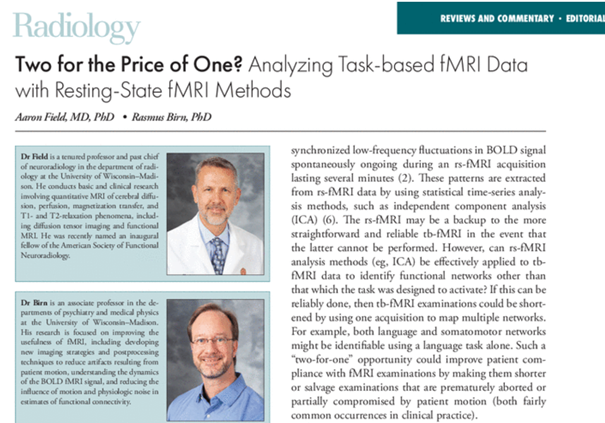1- Are you currently daydreaming while your patient is performing a long MR examination? During these few minutes, do you want to learn more about task-based and resting state functional MRI? Everything you need to know is below
@RadInTrainingEditor @radiology_rsna
#TWEETORIAL
@RadInTrainingEditor @radiology_rsna
#TWEETORIAL
2- A new study from Behestian et al published in @radiology_rsna builds the future of functional brain MRI (fMRI).
pubs.rsna.org/doi/10.1148/ra…
2/12
pubs.rsna.org/doi/10.1148/ra…
2/12

3- If you are already familiar with task-based and resting state fMRI, you can check the InAMinute video about this amazing study.
pubs.rsna.org/doi/10.1148/ra…
3/12
pubs.rsna.org/doi/10.1148/ra…
3/12
4- If not, do you know what resting state functional MRI is? #RadInTraining
5- Functional MRI is based on the fluctuations of blood-oxygen level dependent (BOLD) signal. This signal changes during specific tasks due to local variations of blood flow leading to decrease in deoxygenated hemoglobin.
5/12
5/12

6- During pre-operative brain mapping before brain lesion surgery, patients perform specific tasks, e.g. motor or language tasks. These task-based fMRI sequences are time-consuming and can be difficult for patients to perform. 6/12
7- Resting state fMRI is particularly helpful in these patients, since functional networks can be detected at rest. Many studies focused on the Default Mode Network (task-negative network e.g. activated during daydreaming) but the other functional networks can also be identified 

8- Different types of resting state data analysis exist, including Seed Based Connectivity Analysis and Independent Component Analysis (ICA). The latter allows the extraction of independent components from resting-state fMRI data corresponding to different functional networks. 

9- Resting state fMRI methods such as ICA could be applied to task based fMRI data to identify functional networks other than that which the task was designed to activate. This could shorten fMRI examinations.
9/12
9/12
10- A recently published study by Behestian et al illustrates how resting state fMRI methods can be used to analyze task-based data to map a brain cortical network.
pubs.rsna.org/doi/10.1148/ra…
pubs.rsna.org/doi/10.1148/ra…
11- An accompanying editorial written by Field and Birn develops the clinical implications on this technique for brain tumor resection planning.
pubs.rsna.org/doi/10.1148/ra…
11/12
pubs.rsna.org/doi/10.1148/ra…
11/12

12- CLINICAL IMPLICATIONS:
A single sentence completion fMRI scan could be sufficient to map both the language and the somatomotor networks, with shorter examinations and improved patient compliance.
12/12
A single sentence completion fMRI scan could be sufficient to map both the language and the somatomotor networks, with shorter examinations and improved patient compliance.
12/12
“Identification of the Somatomotor Network from Language Task–based fMRI Compared with Resting-State fMRI in Patients with Brain Lesions”.
pubs.rsna.org/doi/10.1148/ra…
@RadITrainEditor @RadiologyEditor #RadInTraining
pubs.rsna.org/doi/10.1148/ra…
@RadITrainEditor @RadiologyEditor #RadInTraining

• • •
Missing some Tweet in this thread? You can try to
force a refresh





